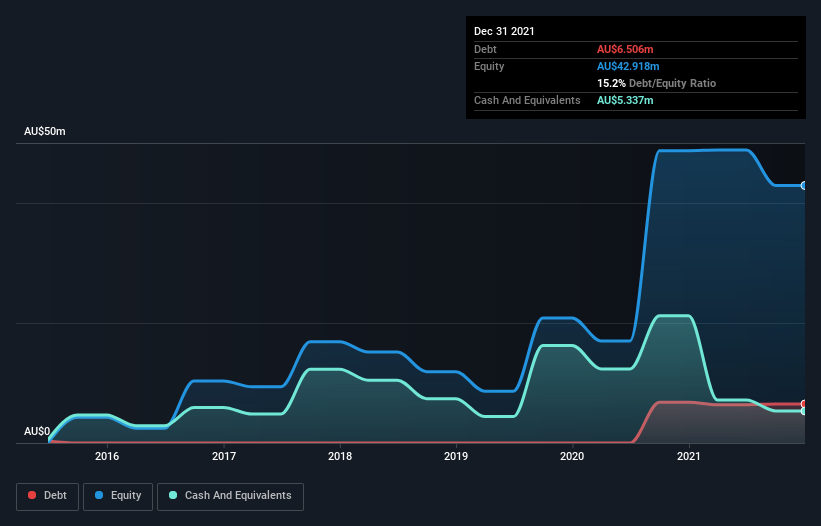
Warren Buffett famously said, 'Volatility is far from synonymous with risk.' So it seems the smart money knows that debt - which is usually involved in bankruptcies - is a very important factor, when you assess how risky a company is. Importantly, MedAdvisor Limited (ASX:MDR) does carry debt. But the more important question is: how much risk is that debt creating?
What Risk Does Debt Bring?
Debt assists a business until the business has trouble paying it off, either with new capital or with free cash flow. If things get really bad, the lenders can take control of the business. While that is not too common, we often do see indebted companies permanently diluting shareholders because lenders force them to raise capital at a distressed price. By replacing dilution, though, debt can be an extremely good tool for businesses that need capital to invest in growth at high rates of return. The first thing to do when considering how much debt a business uses is to look at its cash and debt together.
See our latest analysis for MedAdvisor
How Much Debt Does MedAdvisor Carry?
You can click the graphic below for the historical numbers, but it shows that MedAdvisor had AU$6.51m of debt in December 2021, down from AU$6.81m, one year before. However, because it has a cash reserve of AU$5.34m, its net debt is less, at about AU$1.17m.

How Healthy Is MedAdvisor's Balance Sheet?
Zooming in on the latest balance sheet data, we can see that MedAdvisor had liabilities of AU$27.7m due within 12 months and liabilities of AU$8.51m due beyond that. Offsetting this, it had AU$5.34m in cash and AU$12.3m in receivables that were due within 12 months. So its liabilities total AU$18.6m more than the combination of its cash and short-term receivables.
MedAdvisor has a market capitalization of AU$60.9m, so it could very likely raise cash to ameliorate its balance sheet, if the need arose. However, it is still worthwhile taking a close look at its ability to pay off debt. The balance sheet is clearly the area to focus on when you are analysing debt. But ultimately the future profitability of the business will decide if MedAdvisor can strengthen its balance sheet over time. So if you want to see what the professionals think, you might find this free report on analyst profit forecasts to be interesting.
In the last year MedAdvisor wasn't profitable at an EBIT level, but managed to grow its revenue by 257%, to AU$64m. When it comes to revenue growth, that's like nailing the game winning 3-pointer!
Caveat Emptor
Despite the top line growth, MedAdvisor still had an earnings before interest and tax (EBIT) loss over the last year. Its EBIT loss was a whopping AU$16m. When we look at that and recall the liabilities on its balance sheet, relative to cash, it seems unwise to us for the company to have any debt. So we think its balance sheet is a little strained, though not beyond repair. However, it doesn't help that it burned through AU$11m of cash over the last year. So in short it's a really risky stock. When analysing debt levels, the balance sheet is the obvious place to start. However, not all investment risk resides within the balance sheet - far from it. To that end, you should be aware of the 4 warning signs we've spotted with MedAdvisor .
At the end of the day, it's often better to focus on companies that are free from net debt. You can access our special list of such companies (all with a track record of profit growth). It's free.
New: Manage All Your Stock Portfolios in One Place
We've created the ultimate portfolio companion for stock investors, and it's free.
• Connect an unlimited number of Portfolios and see your total in one currency
• Be alerted to new Warning Signs or Risks via email or mobile
• Track the Fair Value of your stocks
Have feedback on this article? Concerned about the content? Get in touch with us directly. Alternatively, email editorial-team (at) simplywallst.com.
This article by Simply Wall St is general in nature. We provide commentary based on historical data and analyst forecasts only using an unbiased methodology and our articles are not intended to be financial advice. It does not constitute a recommendation to buy or sell any stock, and does not take account of your objectives, or your financial situation. We aim to bring you long-term focused analysis driven by fundamental data. Note that our analysis may not factor in the latest price-sensitive company announcements or qualitative material. Simply Wall St has no position in any stocks mentioned.
About ASX:MDR
MedAdvisor
Provides pharmacy-driven patient engagement solutions in Australia, New Zealand, the United States, and the United Kingdom.
Excellent balance sheet and good value.
Market Insights
Community Narratives


